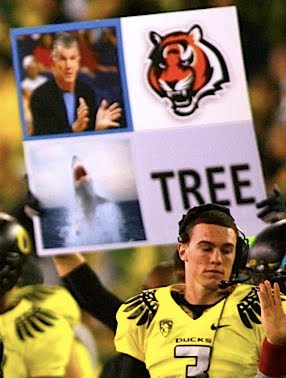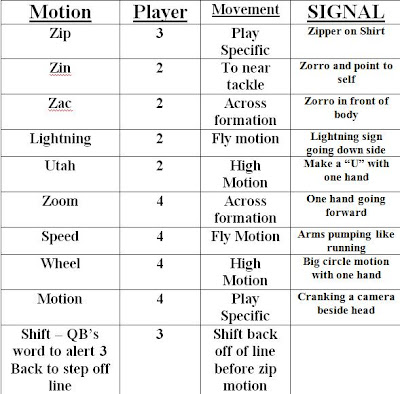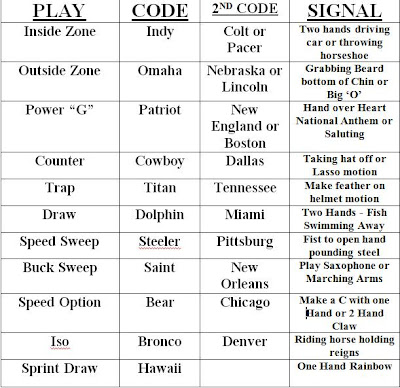As we all anticipate what should be an exciting match up between two explosive offenses in Auburn and Oregon for the National Championship, we may be able to glean some useful lessons from both these teams. Both represent fast-paced no-huddle offenses that are borrowing on basic concepts and adapting them as the lastest offensive innovation. Ironic or fittingly, I suppose, that we covered both teams offenses earlier in the Fall (Oregon / Auburn), but what stands out to most people about each is not their plays or scheme so much, as their method of operation...................fast. In this post, we will provide some insight into how one of these teams facilitates this tempo via sideline signal boards.
While it has garnered quite a bit of attention (and favor) with the BooYah Sports Network by featuring their self-heralded icons during Oregon games, Auburn's similar practice has been rather subdued. Both essentially share the system of communication, along with other offenses (Oklahoma State).
It may appear as complex chaos, the methodology is quite simple. You have a base offense and concepts that you run, all you are doing is eliminating the unnecessary huddle and parsing the relevant pieces of information needed on a given play. The no-huddle concept has been around for a while, but recently it has undergone more efficient tweaking, accentuating the irrelevance of the huddle. If you've ever spent anytime coaching offense, you'll know just how tedious and frustrating it can be dicking around "coaching" the huddle procedure ('YOU go here...you go there....no, no, no...you're supposed to face that way!").
To better explain this process, I've included examples of how this information would be coded and signaled to flesh out how it actually works. Lets explore what needs to be delivered to the players....
Formation
Motion
Play direction
Play Type
This is common information usually shared in the huddle, before anything is presented to the defense. What the no-huddle is doing is presenting a formation, allowing the defense to match it, then call an offensive play based on this information and/or change it (if necessary). All this can be accomplished outside the confines gathering the players together; just line up, get the play, and execute it.
How information is being communicated (the huddle is a waste of resources)
As the offense nears the spot, they will assume the same formation as the last play (though nothing really changes for the offensive line, quarterback, and fullback on most every play). The formation will be signaled (usually by a sideline player) as soon as the previous play ends along with any pre-snap movement until that formation is achieved. Next, the play type will be given to the players. The quarterback will begin the cadence, repeating the playside/series code, and snap the ball. Once the play ends, the next begins and the process repeats.
This necessitates an offense to develop its own language, with multiple terms (and signals) to deliver the same information, so the code cannot be easily ‘cracked’. This is achieved by concept association and by allowing the position units to devise the terms they want to use (ownership of association).
Sideline Communication
The sideline usually features up to four different signalers consisting quarterbacks, receivers, graduate assistants, assistant coaches, and coordinators. These players will be signaling something every down, though not every signaler will be ‘live’ (will be signaling bogus dummy calls). The common method is broken down as follows;
Play Caller: coordinator / coordinator assistant
Signaler: position coach (runs, play action, screens)
Color: player (black or blue = right / white or gold = left / red = play change/check)
Signal Board: GA (passes)
All these individuals will present their signals to the on-field players until the ball is snapped to ensure that no player did not receive the information. So once a play ends, the 'next play' begins with the entire offense setting up on the spot of the ball, looking to their sideline for new information.
The real key to the team of signalers is the Color designator. Colors will determine if the signaler is hot (or the board is hot) as well as reinforce what the playside will be.
Black, White, Green, Pink, Brown – Signaler is Hot
Blue, Gold, Red – Board is Hot
So by this example, after a formation is given and the sideline player signaling “Black” (right is playside / signaler is hot) the players on the field will look to the signaler for the play. If the color signaler is delivering “Blue”, they can understand that the playside is right and the board is hot (i.e. pass routes) and disregard the signaler.
To better explain this process, I've included examples of how this information would be coded and signaled to flesh out how it actually works. Let’s explore what needs to be delivered to the players....
As you can see by the charts above, the no-huddle concept of signaling can deliver this information quickly through association and will generally only affect the 5 specialists on offense.
Next, the play type (run, play action, screen, or pass) can be delivered. The key is to group the play type by genus or series.
“If the reference is X, I will know that the play is going to be ‘this type’, now all I need to know is which one”
In our examples we can classify the play types as;
Runs are represented by NFL teams (or mascot)
Passes are represented by College teams (or mascot)
Play action passes will be represented by the run action signal with a (color) tag
Screens are based off locations (city or state)
We saw this earlier (and it is quite common) during the write-up on Louisiana Tech’s first few practices last spring as well as Bo Pelini’s base defense concepts, where commonly used categories represent different types of plays.
Take these examples for instance;
I=draws the association of “I for IZ” that is commonly tied to the NFL team, Indianapolis Colts, so any horse reference would be able to convey a zone run.
P=draws the association of “P for Power” (i.e. NFL team with a ‘P’ is the Patriots), so all you would have to do is deliver an iconic symbol of what people would associate a ‘patriot’ with.
During this entire process, the quarterback can eyeball the sideline while ‘translating’ audibly to the line and backs…. “Blue, Blue….Cowboy! Cowboy!” (right counter) without the defense really having any idea of what is going on. Alternatively, the very next play could be called “Black, Blue….Dallas! Dallas!”, and still be running the same play.
With passing plays, it is the same process, but this is where the boards come in. If the board is 'hot', the bogus play type will be called out and let the offensive line know it is not run-action, so they will need to listen for the protection. The fullback will then call out a play-specific protection on every down (much like the TFS system will have the back make a 'roger' / 'louie' call each play).
When the board is ‘hot’ the quadrants will represent primary and secondary receiver routes based on the route tree used. So, you could have your passing concepts represented by both associations (NCAA teams/mascots deliver a passing concept) as well as number representations (“20” / “97”). See below for a standard chart for passing concepts and marry them up with the included passing tree.
If you are calling a smash concept, you could just call "Razorback" (Arkansas) or the "20" (or "90"). The "2" in this call would represent the initial read side (right) and the "0" indicates primary receiver running the hitch.

















10 comments:
Kinda of similar to what we do down here in marrero, La. We learned that using names can make playing calling quite long but cn be simplified with number. Awesome site learned so much from it. If you get a chance check out the play of the day.com site
Silly question, maybe, but in practice how does the offense get to practice the signals when the defense knows the verbal calls? I coach 2 way players and I can't tell them to turn off their ears, but you'd have to practice that play calling system.
Awesome info, though. Thanks for the knowledge.
Yeah - good question....
But like those LTU clips from April show, the offensive tempo is so fast in team time even if you knew all the calls it wouldn't help you much because by the time you deciphered ita, it would be coming right at you. If you go no huddle, you bettee get those snaps off quick
yes, you have to coach the huddle..I would say that the huddle can be a source of pride..breaking the huddle and running to the los...a source of encouragement..cmon guys lets do this..IMO more so in HS than in college
We've been running no huddle for a few years now and had that issue with 2 way players.
The first year we would 'sugar huddle' to get the call to the OL, the second year we just taught the calls to the OL, which they were able to pick up easily, since they were only usually looking for a specific couple specific pieces of information (ie. blocking scheme, direction).
I guess it would depend on how complicated your system would be for the OL to learn.
Great site by the way!
As an addendum..........
When you go no-huddle, you provide your offense with the ability to "OC check" (the ability to check out of the original play after going through the cadence), as well as signal in intentions of the defense
Louisiana Tech this year, with Tony Franklin, did this on a regular basis.
coach I saw on the spread football blog that you have different types of film that you may be willing to exchange. I would like to send you my list could you email me at paladino4@archbishopshaw.us
Saw on ESPN this morning a segment about the signs. Coaches and players claimed that each sign had the formation, play, and cadence. ESPN said that they have about 24 cards I think and their walk on QB is responsible for them. I'm skeptical...but if they can make it work for them...so be it.
Coach,
I really appreciate all your help you've given fellow coaches throughout the years.
Currently, We are a TFS team and are adding some two-back runs (similar to Tulsa/Herb Hand) - I've got a couple of his lectures from Tony off of Team Hiway, including his Gap Run/PAP lecture.
I am trying to find some more info on the NCAA route (I know it's common), the PAP Cross, and his Naked series. Any help would be awesome. Thanks.
coach bindel,
hit me up at brophyfootball@gmail.com
I've got a proposition for you.
Post a Comment